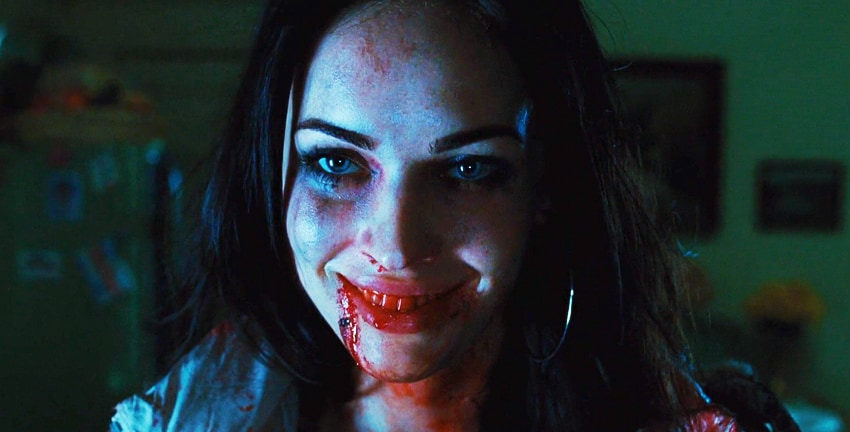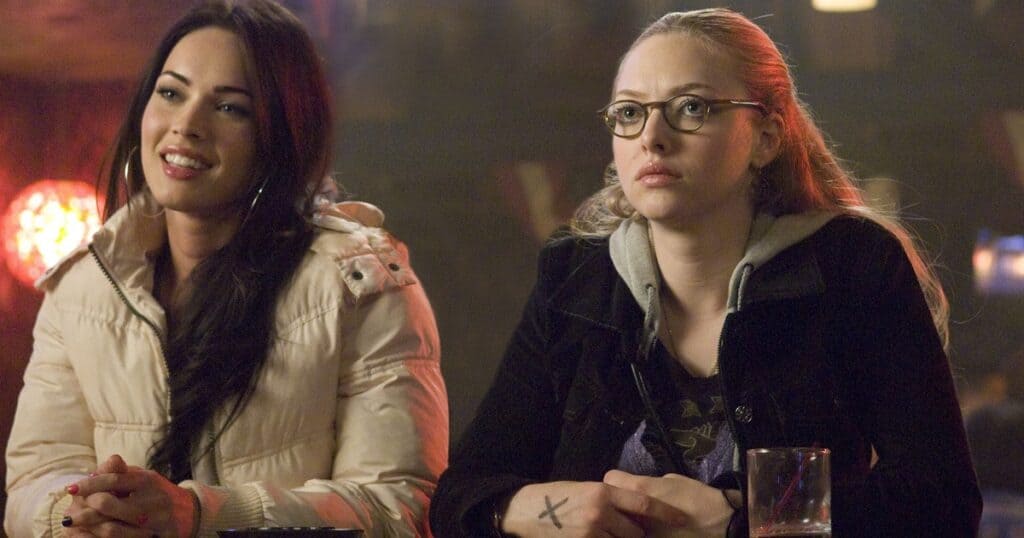
The Jennifer’s Body episode of Revisited was Written and Narrated by Vannah Taylor, Edited by Juan Jimenez, Produced by Tyler Nichols and John Fallon, and Executive Produced by Berge Garabedian.
I love campy teen fodder as much as the next horror fan, but sometimes the film we buy a ticket to see is not exactly what we were given in the trailer…A testosterone-fueled movie about underground fighting might actually be a dark satire that deconstructs masculinity, like Fight Club. Quirky romantic comedies end up being soul-crushing melancholic dramas like Eternal Sunshine of the Spotless Mind. And sometimes you have to find out the hard way that “reimagined classic” is marketing speak for, “this is a musical.” But one misunderstood gem forever stands out to me for being a powerful film ahead of its time. A commentary on female friendship, revenge, and the commodification of women’s bodies was hidden within an offbeat bloodbath about a hot chick who eats boys. Let’s dive into a whirlpool to explore the depths of the 2009 horror comedy, Jennifer’s Body (get it HERE).
Directed by Karyn Kusama, Jennifer’s Body follows Anita Lesnicki or Needy (portrayed by Amanda Seyfried), as she makes sense of the tragedy and carnage plaguing her small town of Devil’s Kettle–home of an unusual waterfall that feeds into a whirlpool with seemingly no exit (which is interestingly a real location in Minnesota’s Magney State Park that you can add to your next road trip). At the center of it all the terror is the center of Needy’s life–the now horror icon, Jennifer Check. Megan Fox portrays THE “it girl” of Devil’s Kettle. Popular and gorgeous, she embodies what every guy wants, and every girl wants to be. She seems bright and playful but, in reality, her “tell it like it is” attitude hits a little too hard. You want to hate her, but like everyone in Devil’s Kettle, you’re just awestruck and honored to be in her presence. Yet, girls like her have their weaknesses, too.
After a fire disrupts the pair’s night out to see an indie rock band, Low Shoulder—Jennifer, in shock and falling victim to the “cool guy from the city” charm, leaves with the band while Needy wonders what fate might befall her best friend. Fans of the riot grrrl movement might recognize the name of the film as a track released by Hole–fronted by the infamous Courtney Love. Hole fan Diablo Cody mirrors the lyrics of the song with her script, telling the story of a girl kidnapped and murdered, but instead of dismembered in a box somewhere, we see what happens when a satanic sacrifice backfires!
The film runs with this musical genesis by making music an essential aspect of the narrative, production design, and casting. Cody’s script honors its feminist punk inspirations by making the real villains of the story members of an indie rock band who choose to prey on unsuspecting young girls from the honest Midwest, brutalizing them in the name of their ambitions to make it big. The filmmakers had hoped to cast an actual rock musician to portray the frontrunner of Low Shoulder, Nikolai Wolf, with Pete Wentz of Fall Out Boy and Joel Madden of Good Charlotte being considered for the role. Eventually, Adam Brody was cast for the role and perfectly portrays a special kind of sleazy wannabe rock star that all the girls regrettably had a crush on. Brody himself is not necessarily a singer, so Nikolai’s vocals were provided by indie rock artist Ryan Levine, who is still seen on screen as another member of Low Shoulder. The music seen and heard creates the whole vibe of the movie. Production designer Arv Grewal nailed the decorating of these teen’s rooms, with posters of bands like Fall Out Boy and Motion City Soundtrack. If I didn’t know any better, I would have thought he clicked right onto my own Myspace page for inspiration. Not to mention, the film’s early 2000s alt-rock soundtrack features Panic! At the Disco, All Time Low, Dashboard Confessional, and many more iconic artists—which makes every viewing of this film transports me back to my teenage years. If I’m feeling nostalgic enough, I could probably find my own Panic! and All Time Low ticket stubs hidden in my childhood bedroom. My personal favorite touch is the ending sequence, featuring the Hole song Violet, which comes from the very same album that is home to the film’s namesake.

What Diablo Cody does wonderfully in her writing is play suburbia and the everyday situations we have come to recognize as part of our own coming-of-age tales to a level of absurdity that almost circles back to a deformed realism. Hot off her first screenplay for Juno, Diablo Cody decided to showcase her sarcastic wit and dark sense of humor by “simultaneously trying to pay tribute to some of the conventions that we’ve already seen in horror, yet, at the same time, kind of turn them on their ear.” She also cites influences like The Lost Boys, which is easy to see when you piece together that the two films are coming-of-age tales centered on a protagonist’s friendship, infatuation and debatable borderline worship of the film’s supernatural villain–topped with homoeroticism. Despite all of these similarities, there is still something so unique about the way this film interrogates and showcases the singularity and complexity of teenage girlhood and the difficulty of navigating those relationships.
Seyfried’s character being given the nickname “Needy” underlines the dynamic between her and Jennifer. The pressures that teen girl’s face create hierarchies that revolve around girls like Fox’s character, who is, as Cody states, “a product of a culture that pressures girls to be skinny, beautiful and just like movie stars.” The insecurities that bud from these pressures make way for something horrific as the intensity of what is supposed to be friendship becomes distorted into something parasitic. But this relationship cuts even deeper than that…
While misinterpreted as simply queerbaiting and some sort of stunt for the sake of getting boys in seats, there is a tangible romance between Needy and Jennifer that is profound and essential for understanding their dynamic. Needy states that “sandbox love never dies” and Cody has discussed the experiences that many girls, regardless of orientation, can related to–saying that “there is a sexual energy between the girls which is kind of authentic, because I know when I was a teen-aged girl, the friendships that I had with other girls were almost romantic, they were so intense. I wanted to sleep at my friend’s house every night, I wanted to wear her clothes, we would talk on the phone until our ears ached.” We see a connection between the two during their parallel experiences, like Needy’s visions during the mauling of Colin Gray, portrayed by horror fan favorite Kyle Gallner, and later when she can feel Chip on her lips. This can be read through the lens of the competition girls feel with one another, like when Jennifer demands Chip say she’s better than Needy. But there’s something to be said about the bisexuality of these characters who most likely found that desire the same way many unsuspecting girls do during their sleepovers, “playing boyfriend-girlfriend” in the safety of their own bedrooms as parents often don’t suspect that sometimes girls are more than just BFFs.
While this is a touchy subject for most when it comes to teenagers, this film does not shy away from letting its teens express their desires. It’s fearless and actually progressive in the way it shows a healthy and confident relationship, as we see between Needy and Chip, who are not shy on the subject. The film also debunks the idea we have, or as Rene Rodriguez puts it: “the notion that only “bad girls have sex when they’re 16 [and the] good ones—those who, like Needy, do their homework and are responsible—never slide past first base.”
Perhaps another heavily misunderstood aspect of Kusama’s film is that, despite being the monster or villain of the story, there is a lot of sympathy shown towards this misunderstood teenage girl. The extreme high and low emotions of puberty are one thing to have to deal with. The pressures of being a beauty queen are another. Being sacrificed and accidentally transformed into a succubus is a whole new level. Jennifer is regarded as an ideal girl, idolized for exactly what the film’s title states: her body. Her image is so important to her that the film uses a demonic possession to turn that reliance into a literal curse—what was once her social survival in the murky waters of high school, is now the mark of her actual survival, indicating that she needs to feed. The only thing about her that the world has told her matters now depends entirely on devouring boys…and that is not her fault. Cody mentions the sympathy seen in the film present when we see her, sitting at the vanity, smearing her makeup over her face, distraught at the distortion of her perfect image, stating “I always thought that was such a sad image. She’s so vulnerable. I don’t know any woman who hasn’t had a moment sitting in front of the mirror and thinking, ‘Help me, I want to be somebody else.’”

These moments in this film show that it was not just Jennifer who had power over Needy, but that Needy–in the way that she plays the subservient role that she has been forced into–actually holds the power in the relationship. This is shown through key moments in the film, like when Needy accuses the “Snowflake Queen’ of being insecure, her extremely defensive remarks like “How could I ever be insecure? God, that’s a joke,” shows that a nerve was struck. Most importantly, when she rips off the heart-shaped BFF necklace, the symbol of the power and intensity of their relationship, this is what ultimately allows Needy to take back her power and drive that boxcutter right into Jennifer’s heart.
Many did not and probably still don’t feel the love for Jennifer’s Body. The film had a disappointing box office performance (produced for $16 million, $6.8 domestic opening weekend, eventually grossing around $31 million internationally), and the film fell into a very average range on various critic aggregate sites, receiving criticism for not being funny or scary enough and Megan Fox being straight up called a “a pretty bad actress” (Michael Phillips, Chicago Tribune) or referred to as “the Transformers boy-toy” (Joe Neumaier, New York Daily News). But even the positive reviews seem to misunderstand what is really happening in this story. For example, Roger Ebert, while enjoying the film, christened it a “Twilight for boys.”
Many, including Diablo Cody, fault the marketing of the film for this misguided and poor reception, which leaned too far into appealing to boys who simply think Megan Fox is hot and hit the ground running with the infamous bedroom kiss between the film’s main duo. So, when its substance did not necessarily speak to this arousing marketing package, viewers did not know how to digest.
However, this film has made its resurgence. There is an unspoken power in the relationships of teen girls and there is something special about films that can perfectly depict the horrific experience of adolescence. This is what allows audiences to latch onto Jennifer’s Body as a cult classic and a reclaimed feminist masterpiece. Horror fans have embraced this film not just as a fun teen comedy about a boy-killing succubus but as a supernatural revenge fantasy–indulging in watching a teenage girl find her power after the violence that was enacted on her body. What didn’t kill Jennifer made her stronger!
Two previous episodes of Revisited can be seen below. To see more of our shows, head over to the JoBlo Horror Originals channel – and subscribe while you’re at it!
The post Jennifer’s Body (2009) Revisited – Horror Movie Review appeared first on JoBlo.
Leave a Reply